Deck 4: Gravity and Orbits
Question
Question
Question
Question
Question
Question
Question
Question
Question
Question
Question
Question
Question
Question
Question
Question
Question
Question
Question
Question
Question
Question
Question
Question
Question
Question
Question
Question
Question
Question
Question
Question
Question
Question
Question
Question
Question
Question
Question
Question
Question
Question
Question
Question
Question
Question
Question
Question
Question
Question
Question
Question
Question
Question
Question
Question
Question
Question
Question
Question
Question
Question
Question
Question
Question
Question
Question
Question
Question
Question
Question
Question
Question
Question
Question
Question
Question
Question
Question
Question

Unlock Deck
Sign up to unlock the cards in this deck!
Unlock Deck
Unlock Deck
1/100
Play
Full screen (f)
Deck 4: Gravity and Orbits
1
The force of gravity between Saturn and the Sun is ________ the force of gravity between Earth and the Sun.For reference, Saturn is approximately 100 times more massive than Earth, and the semimajor axis of Saturn's orbit is 10 AU.
A) 10 times smaller than
B) 1,000 times larger than
C) 1,000 times smaller than
D) 100 times larger than
E) approximately equal to
A) 10 times smaller than
B) 1,000 times larger than
C) 1,000 times smaller than
D) 100 times larger than
E) approximately equal to
approximately equal to
2
The distance used in Newton's law of gravitation is
A) the distance between the closest faces of the two objects.
B) the distance between the centers of the objects.
C) the radius of the largest object.
D) the radius of the smallest object.
E) always the same.
A) the distance between the closest faces of the two objects.
B) the distance between the centers of the objects.
C) the radius of the largest object.
D) the radius of the smallest object.
E) always the same.
the distance between the centers of the objects.
3
If you weighed 150 lb on Earth, what would you weigh on Mars? For reference, Mars has a mass that is 0.1 times Earth's mass and Mars has a radius that is 0.5 times Earth's radius.
A) 30 lb
B) 110 lb
C) 75 lb
D) 60 lb
E) 15 lb
A) 30 lb
B) 110 lb
C) 75 lb
D) 60 lb
E) 15 lb
60 lb
4
Which of the following properties of an astronaut changes when he or she is standing on the Moon, relative to when the astronaut is standing on Earth?
A) weight
B) mass
C) inertia
D) height
E) Nothing changes.
A) weight
B) mass
C) inertia
D) height
E) Nothing changes.

Unlock Deck
Unlock for access to all 100 flashcards in this deck.
Unlock Deck
k this deck
5
Suppose you are suddenly transported to a planet with 1/4 the mass of Earth but the same radius as Earth.Your weight would ________ by a factor of ________.
A) increase; 4
B) increase; 16
C) decrease; 4
D) decrease; 16
E) increase; 2
A) increase; 4
B) increase; 16
C) decrease; 4
D) decrease; 16
E) increase; 2

Unlock Deck
Unlock for access to all 100 flashcards in this deck.
Unlock Deck
k this deck
6
If a person having mass, M, is standing on the ground and experiencing an acceleration due to gravity of g, what is the correct formula for the person's weight, F?
A) F =mg2
B) F= mg
C) F = m/g
D) F = g/m
E) F = m
A) F =mg2
B) F= mg
C) F = m/g
D) F = g/m
E) F = m

Unlock Deck
Unlock for access to all 100 flashcards in this deck.
Unlock Deck
k this deck
7
The force of gravity that an object has is directly proportional to its
A) inertia.
B) size.
C) mass.
D) density.
E) distance.
A) inertia.
B) size.
C) mass.
D) density.
E) distance.

Unlock Deck
Unlock for access to all 100 flashcards in this deck.
Unlock Deck
k this deck
8
An astronaut who weighs 700 N on Earth is in empty space, very far from any other objects.Approximately what is the mass of the astronaut?
A) 0
B) 7 kg
C) 70 kg
D) 700 kg
E) 7,000 kg
A) 0
B) 7 kg
C) 70 kg
D) 700 kg
E) 7,000 kg

Unlock Deck
Unlock for access to all 100 flashcards in this deck.
Unlock Deck
k this deck
9
Two rocks (call them S and T) are a distance of 50 km from one another in empty space.Rock S has 20 times the mass of rock T.Considering only their mutual gravitational force, which rock will accelerate faster in response to gravity?
A) rock S
B) rock T
C) Both rocks will have the same acceleration.
D) Neither rock will accelerate.
E) Not enough information is available to answer.
A) rock S
B) rock T
C) Both rocks will have the same acceleration.
D) Neither rock will accelerate.
E) Not enough information is available to answer.

Unlock Deck
Unlock for access to all 100 flashcards in this deck.
Unlock Deck
k this deck
10
Two rocks (call them S and T) are released at the same time from the same height and start from rest.Rock S has 20 times the mass of rock T.Which rock will fall faster if the only forces involved are each rock's mutual gravitational attraction with Earth?
A) rock S
B) rock T
C) Both rocks will fall at the same rate.
D) Not enough information is available to answer.
E) Neither rock will fall, because they will remain at rest.
A) rock S
B) rock T
C) Both rocks will fall at the same rate.
D) Not enough information is available to answer.
E) Neither rock will fall, because they will remain at rest.

Unlock Deck
Unlock for access to all 100 flashcards in this deck.
Unlock Deck
k this deck
11
If the distance between Earth and the Sun were cut in half, the gravitational force between these two objects would
A) decrease by a factor of 4.
B) decrease by a factor of 2.
C) increase by a factor of 2.
D) increase by a factor of 4.
E) decrease by a factor of 8.
A) decrease by a factor of 4.
B) decrease by a factor of 2.
C) increase by a factor of 2.
D) increase by a factor of 4.
E) decrease by a factor of 8.

Unlock Deck
Unlock for access to all 100 flashcards in this deck.
Unlock Deck
k this deck
12
Suppose you are suddenly transported to a planet that had 1/4 the radius of Earth but the same mass as Earth.Your weight would ________ by a factor of ________.
A) increase; 4
B) increase; 16
C) decrease; 4
D) decrease; 16
E) decrease; 8
A) increase; 4
B) increase; 16
C) decrease; 4
D) decrease; 16
E) decrease; 8

Unlock Deck
Unlock for access to all 100 flashcards in this deck.
Unlock Deck
k this deck
13
A quantity that follows an inverse square law
A) increases as distance increases, as r2.
B) decreases as distance increases, as 1/r2.
C) decreases as distance increases, as 1/r.
D) increases as distance increases, as r.
E) does not depend on distance.
A) increases as distance increases, as r2.
B) decreases as distance increases, as 1/r2.
C) decreases as distance increases, as 1/r.
D) increases as distance increases, as r.
E) does not depend on distance.

Unlock Deck
Unlock for access to all 100 flashcards in this deck.
Unlock Deck
k this deck
14
Earth is held together in the shape of a sphere.This is due to
A) chemical bonds.
B) pressure from the Sun.
C) its rotation rate.
D) tidal forces.
E) its self-gravity.
A) chemical bonds.
B) pressure from the Sun.
C) its rotation rate.
D) tidal forces.
E) its self-gravity.

Unlock Deck
Unlock for access to all 100 flashcards in this deck.
Unlock Deck
k this deck
15
Between any two objects with mass, the force of gravity is always
A) different for each mass.
B) the same value, regardless of the masses involved.
C) attractive.
D) a fictitious force.
E) repulsive.
A) different for each mass.
B) the same value, regardless of the masses involved.
C) attractive.
D) a fictitious force.
E) repulsive.

Unlock Deck
Unlock for access to all 100 flashcards in this deck.
Unlock Deck
k this deck
16
The force of gravity between Earth and the Sun is approximately ________ the force of gravity between Earth and the Moon.For reference, the average distance between Earth and the Moon is 0.003 astronomical unit (AU), the mass of the Moon is 7 * 1022 kg, and the mass of the Sun is 2 * 1030 kg.
A) 86,000 times larger than
B) 260 times larger than
C) 140 times smaller than
D) 6,400 times smaller than
E) the same as
A) 86,000 times larger than
B) 260 times larger than
C) 140 times smaller than
D) 6,400 times smaller than
E) the same as

Unlock Deck
Unlock for access to all 100 flashcards in this deck.
Unlock Deck
k this deck
17
In the absence of air friction, a 0.001-kg piece of paper and a 0.1-kg notebook are dropped from the same height and allowed to fall to the ground.How do their accelerations compare?
A) The accelerations are the same.
B) The notebook's acceleration is 100 times faster than the paper's acceleration.
C) The notebook's acceleration is 1,000 times faster than the paper's acceleration.
D) The paper's acceleration is 100 times faster than the notebook's acceleration.
E) The paper's acceleration is 1,000 times faster than the notebook's acceleration.
A) The accelerations are the same.
B) The notebook's acceleration is 100 times faster than the paper's acceleration.
C) The notebook's acceleration is 1,000 times faster than the paper's acceleration.
D) The paper's acceleration is 100 times faster than the notebook's acceleration.
E) The paper's acceleration is 1,000 times faster than the notebook's acceleration.

Unlock Deck
Unlock for access to all 100 flashcards in this deck.
Unlock Deck
k this deck
18
According to the scales shown in the figure below, about how many times stronger is gravity on Earth than on the Moon? 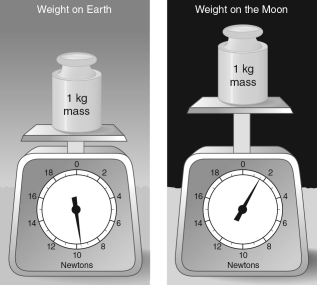
A) 20
B) 3
C) 2
D) 6
E) They are the same.

A) 20
B) 3
C) 2
D) 6
E) They are the same.

Unlock Deck
Unlock for access to all 100 flashcards in this deck.
Unlock Deck
k this deck
19
If you weighed 100 lb on Earth, what would you weigh at the upper atmosphere of Jupiter? For reference, Jupiter has a mass that is about 300 times Earth's mass and a radius that is 10 times Earth's radius.
A) 10,000 lb
B) 3,000 lb
C) 1,000 lb
D) 300 lb
E) 30 lb
A) 10,000 lb
B) 3,000 lb
C) 1,000 lb
D) 300 lb
E) 30 lb

Unlock Deck
Unlock for access to all 100 flashcards in this deck.
Unlock Deck
k this deck
20
According to the progression shown in the figure below, if the distance between two objects is increased to four times its original value, the gravitational force between the two objects would be ________ times its original value. 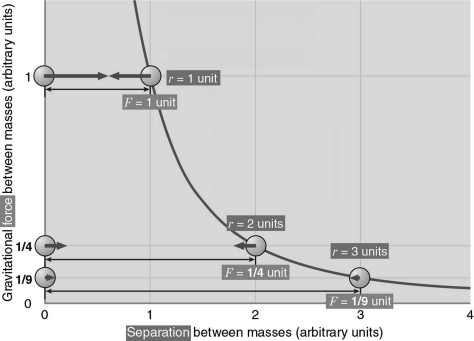
A) 1/2
B) 1/32
C) 1/4
D) 1/16
E) 4

A) 1/2
B) 1/32
C) 1/4
D) 1/16
E) 4

Unlock Deck
Unlock for access to all 100 flashcards in this deck.
Unlock Deck
k this deck
21
Astronauts orbiting Earth in the space shuttle experience so-called weightlessness in space because
A) they are farther away from Earth.
B) of centrifugal force.
C) the gravitational pull of the Moon counteracts Earth's gravitational pull.
D) they are in constant free fall around Earth.
E) they are in space where there is no gravity.
A) they are farther away from Earth.
B) of centrifugal force.
C) the gravitational pull of the Moon counteracts Earth's gravitational pull.
D) they are in constant free fall around Earth.
E) they are in space where there is no gravity.

Unlock Deck
Unlock for access to all 100 flashcards in this deck.
Unlock Deck
k this deck
22
Which of the following is an unbound orbit?
A) elliptical
B) hyperbolic
C) circular
D) All of these are unbound orbits.
E) None of these are unbound orbits.
A) elliptical
B) hyperbolic
C) circular
D) All of these are unbound orbits.
E) None of these are unbound orbits.

Unlock Deck
Unlock for access to all 100 flashcards in this deck.
Unlock Deck
k this deck
23
What is the escape velocity from Mars if its mass is 6 *1023 kg and its radius is 3,400 km?
A) 2,400 m/s
B) 4,900 m/s
C) 8,600 km/s
D) 12,000 m/s
E) 25,000 km/s
A) 2,400 m/s
B) 4,900 m/s
C) 8,600 km/s
D) 12,000 m/s
E) 25,000 km/s

Unlock Deck
Unlock for access to all 100 flashcards in this deck.
Unlock Deck
k this deck
24
You find a moon orbiting a planet.The moon has a period of 10 days, and the average distance between the moon and planet is 106 km.What is the planet's mass? Note that the mass of Jupiter is 1.9 * 1027 kg.
A) 0.1 MJupiter
B) 0.4 MJupiter
C) 1 MJupiter
D) 4 MJupiter
E) 10 MJupiter
A) 0.1 MJupiter
B) 0.4 MJupiter
C) 1 MJupiter
D) 4 MJupiter
E) 10 MJupiter

Unlock Deck
Unlock for access to all 100 flashcards in this deck.
Unlock Deck
k this deck
25
If we wanted to increase the Hubble Space Telescope's altitude above Earth and keep it in a stable orbit, we also would need to
A) increase its orbital speed.
B) increase its weight.
C) decrease its weight.
D) decrease its orbital speed.
E) increase its mass.
A) increase its orbital speed.
B) increase its weight.
C) decrease its weight.
D) decrease its orbital speed.
E) increase its mass.

Unlock Deck
Unlock for access to all 100 flashcards in this deck.
Unlock Deck
k this deck
26
Which of the following is true considering Newton's laws of motion and Newton's law of gravitation?
A) They disprove Galileo's law of inertia.
B) They only work when describing perfectly circular orbits.
C) They support a geocentric Solar System.
D) They can be used to produce Kepler's three laws.
E) They are only valid in deep space.
A) They disprove Galileo's law of inertia.
B) They only work when describing perfectly circular orbits.
C) They support a geocentric Solar System.
D) They can be used to produce Kepler's three laws.
E) They are only valid in deep space.

Unlock Deck
Unlock for access to all 100 flashcards in this deck.
Unlock Deck
k this deck
27
If you found an exoplanet whose mass was the same as Jupiter's, but the planet orbited its star with a period of 2 years and a semimajor axis of 1 AU, what would be the mass of its star? For reference, Jupiter has a semimajor axis of 5.4 AU and an orbital period of 12 years.
A) 0.25 MSun
B) 0.5 MSun
C) 2.0 MSun
D) 1.5 MSun
E) 4.0 MSun
A) 0.25 MSun
B) 0.5 MSun
C) 2.0 MSun
D) 1.5 MSun
E) 4.0 MSun

Unlock Deck
Unlock for access to all 100 flashcards in this deck.
Unlock Deck
k this deck
28
Mercury orbits the Sun with an average distance of 0.4 AU, and its mass is 0.06 times that of Earth.The gravitational force that the Sun exerts on Mercury is approximately ________ times the force of gravity that the Sun exerts on Earth.
A) 20
B) 6
C) 4
D) 0.4
E) 0.1
A) 20
B) 6
C) 4
D) 0.4
E) 0.1

Unlock Deck
Unlock for access to all 100 flashcards in this deck.
Unlock Deck
k this deck
29
The Hubble Space Telescope orbits at an altitude of 600 km above Earth's surface.Assuming it is in a stable circular orbit, what is its velocity? For reference, Earth's radius is 6,400 km and Earth's mass is 6* 1024 kg.
A) 240,000 m/s
B) 7,500 m/s
C) 51,000 m/s
D) 64,000 m/s
E) You also must know the mass of the Hubble Space Telescope to determine its speed.
A) 240,000 m/s
B) 7,500 m/s
C) 51,000 m/s
D) 64,000 m/s
E) You also must know the mass of the Hubble Space Telescope to determine its speed.

Unlock Deck
Unlock for access to all 100 flashcards in this deck.
Unlock Deck
k this deck
30
What is the escape velocity from Ceres if its mass is 9 * 1020 kg and its radius is 470 km?
A) 98 km/s
B) 200 km/s
C) 340 m/s
D) 500 m/s
E) 12,400 m/s
A) 98 km/s
B) 200 km/s
C) 340 m/s
D) 500 m/s
E) 12,400 m/s

Unlock Deck
Unlock for access to all 100 flashcards in this deck.
Unlock Deck
k this deck
31
If you have two moons that have the same radius, but Moon A is denser and has 2 times the mass of Moon B, how do their escape velocities from their respective surfaces compare?
A) Moon A has an escape velocity that is 1.4 times larger than Moon B.
B) Moon A has an escape velocity that is 1.4 times smaller than Moon B.
C) Moon A has an escape velocity that is 2 times smaller than Moon B.
D) Moon A has an escape velocity that is 2 times larger than Moon B.
E) Because gravity affects all masses the same, the escape velocities are the same.
A) Moon A has an escape velocity that is 1.4 times larger than Moon B.
B) Moon A has an escape velocity that is 1.4 times smaller than Moon B.
C) Moon A has an escape velocity that is 2 times smaller than Moon B.
D) Moon A has an escape velocity that is 2 times larger than Moon B.
E) Because gravity affects all masses the same, the escape velocities are the same.

Unlock Deck
Unlock for access to all 100 flashcards in this deck.
Unlock Deck
k this deck
32
If you measured the orbital period of the Moon and the distance between Earth and the Moon, then you could calculate
A) the mass of the Moon.
B) the sum of the masses of Earth and the Moon.
C) the average distance between Earth and the Sun.
D) the radius of Earth.
E) the radius of the Moon.
A) the mass of the Moon.
B) the sum of the masses of Earth and the Moon.
C) the average distance between Earth and the Sun.
D) the radius of Earth.
E) the radius of the Moon.

Unlock Deck
Unlock for access to all 100 flashcards in this deck.
Unlock Deck
k this deck
33
In a circular orbit, the force of gravity provides a/an
A) inertial reference frame.
B) drag force.
C) centripetal force.
D) attractive force that destroys the orbit.
E) source of energy to sustain the orbit.
A) inertial reference frame.
B) drag force.
C) centripetal force.
D) attractive force that destroys the orbit.
E) source of energy to sustain the orbit.

Unlock Deck
Unlock for access to all 100 flashcards in this deck.
Unlock Deck
k this deck
34
The definition of the term satellite in astronomy refers to
A) a means of communication.
B) a man-made object in orbit of Earth.
C) the Moon.
D) any low-mass object that is orbiting a more massive object.
E) none of the above
A) a means of communication.
B) a man-made object in orbit of Earth.
C) the Moon.
D) any low-mass object that is orbiting a more massive object.
E) none of the above

Unlock Deck
Unlock for access to all 100 flashcards in this deck.
Unlock Deck
k this deck
35
Uniform circular motion applies to which of the following orbits?
A) elliptical
B) hyperbolic
C) circular
D) parabolic
E) All of these options are correct.
A) elliptical
B) hyperbolic
C) circular
D) parabolic
E) All of these options are correct.

Unlock Deck
Unlock for access to all 100 flashcards in this deck.
Unlock Deck
k this deck
36
If an object is in orbit with an orbital speed less than the escape speed but greater than the circular orbit speed, what type of orbit is it?
A) elliptical
B) hyperbolic
C) circular
D) parabolic
E) none of these
A) elliptical
B) hyperbolic
C) circular
D) parabolic
E) none of these

Unlock Deck
Unlock for access to all 100 flashcards in this deck.
Unlock Deck
k this deck
37
For which of the following orbital velocities, V, is the orbit unbound?
A) V just below escape velocity
B) V = circular velocity
C) V escape velocity
D) V escape velocity
E) V = 0
A) V just below escape velocity
B) V = circular velocity
C) V escape velocity
D) V escape velocity
E) V = 0

Unlock Deck
Unlock for access to all 100 flashcards in this deck.
Unlock Deck
k this deck
38
If a robotic probe sent to Mars is designed to return a rock sample to Earth, how fast must the probe be launched from the surface of Mars in order to escape the gravity of Mars? For reference, Mars has a mass of 6 *1023 kg and a radius of 3,400 km.
A) 100 m/s
B) 4,900 m/s
C) 20 m/s
D) 20,000 m/s
E) You must know the mass of the satellite to determine the answer.
A) 100 m/s
B) 4,900 m/s
C) 20 m/s
D) 20,000 m/s
E) You must know the mass of the satellite to determine the answer.

Unlock Deck
Unlock for access to all 100 flashcards in this deck.
Unlock Deck
k this deck
39
How fast is the Moon moving as it orbits Earth? For reference, the Moon's orbit is approximately circular with a radius equal to 400,000 km, and the Moon's orbital period is 27 days.
A) 1 km/s
B) 10 km/s
C) 50 km/s
D) 100 km/s
E) 500 km/s
A) 1 km/s
B) 10 km/s
C) 50 km/s
D) 100 km/s
E) 500 km/s

Unlock Deck
Unlock for access to all 100 flashcards in this deck.
Unlock Deck
k this deck
40
Titan, the largest moon of Saturn, has an orbital period of 16 days and a semimajor axis of 1.2 *109 m.Based on this information, what is Saturn's mass? For reference, Earth's mass is
6 * 1024 kg.
A) 290 MEarth
B) 130 MEarth
C) 90 MEarth
D) 40 MEarth
E) 4 MEarth
6 * 1024 kg.
A) 290 MEarth
B) 130 MEarth
C) 90 MEarth
D) 40 MEarth
E) 4 MEarth

Unlock Deck
Unlock for access to all 100 flashcards in this deck.
Unlock Deck
k this deck
41
Why is there a tidal bulge on the far (opposite) side of Earth from the Moon?
A) The mass of the far side is smaller than that of the near side.
B) Inertia leaves a bulge behind from earlier in Earth's rotation.
C) This phenomenon has yet to be explained by a satisfying scientific theory.
D) Earth's far side "lags behind" its center.
E) Gravity can be repulsive as well as attractive.
A) The mass of the far side is smaller than that of the near side.
B) Inertia leaves a bulge behind from earlier in Earth's rotation.
C) This phenomenon has yet to be explained by a satisfying scientific theory.
D) Earth's far side "lags behind" its center.
E) Gravity can be repulsive as well as attractive.

Unlock Deck
Unlock for access to all 100 flashcards in this deck.
Unlock Deck
k this deck
42
According to the figure below, the approximate amount of time between a high tide and a low tide at a given location is about 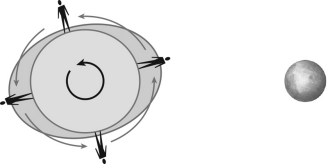
A) 3 hours.
B) 8 hours.
C) 6 hours.
D) 12 hours.
E) 24 hours.

A) 3 hours.
B) 8 hours.
C) 6 hours.
D) 12 hours.
E) 24 hours.

Unlock Deck
Unlock for access to all 100 flashcards in this deck.
Unlock Deck
k this deck
43
According to the figure below, spring tides occur at which phases of the Moon? 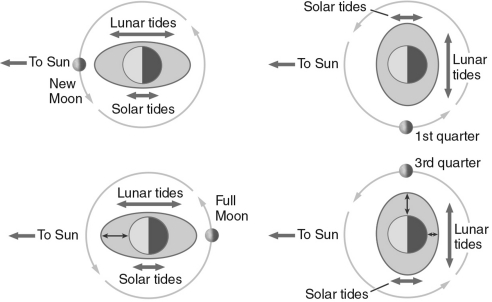
A) third quarter
B) new and full
C) first and third quarters
D) full
E) new

A) third quarter
B) new and full
C) first and third quarters
D) full
E) new

Unlock Deck
Unlock for access to all 100 flashcards in this deck.
Unlock Deck
k this deck
44
According to the figure below, the approximate amount of time between two high tides at a given location is about 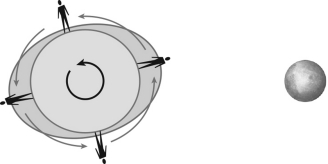
A) 3 hours.
B) 8 hours.
C) 6 hours.
D) 12 hours.
E) 24 hours.

A) 3 hours.
B) 8 hours.
C) 6 hours.
D) 12 hours.
E) 24 hours.

Unlock Deck
Unlock for access to all 100 flashcards in this deck.
Unlock Deck
k this deck
45
According to the figure below, a high tide at a given location will occur about ________ time(s) a day. 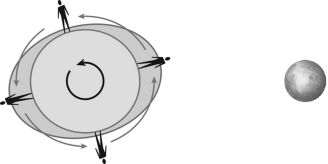
A) one
B) three
C) two
D) four
E) eight

A) one
B) three
C) two
D) four
E) eight

Unlock Deck
Unlock for access to all 100 flashcards in this deck.
Unlock Deck
k this deck
46
Lunar tides are approximately ________ solar tides.
A) 2 times weaker than
B) 2 times stronger than
C) 200 times weaker than
D) 200 times stronger than
E) the same strength as
A) 2 times weaker than
B) 2 times stronger than
C) 200 times weaker than
D) 200 times stronger than
E) the same strength as

Unlock Deck
Unlock for access to all 100 flashcards in this deck.
Unlock Deck
k this deck
47
Tidal forces are caused by
A) the weight of the water on the ocean floor.
B) the strength of the gravitation pull of the Moon on Earth.
C) the difference between the weight of the water on the ocean floor at high and low tide.
D) the difference between the strength of the gravitational pull of the Moon and Sun on either side of Earth.
E) the strength of the gravitation pull of the Moon and the Sun on Earth.
A) the weight of the water on the ocean floor.
B) the strength of the gravitation pull of the Moon on Earth.
C) the difference between the weight of the water on the ocean floor at high and low tide.
D) the difference between the strength of the gravitational pull of the Moon and Sun on either side of Earth.
E) the strength of the gravitation pull of the Moon and the Sun on Earth.

Unlock Deck
Unlock for access to all 100 flashcards in this deck.
Unlock Deck
k this deck
48
According to the figure below, spring tides occur when the lunar and solar tides ________, resulting in ________ tides. 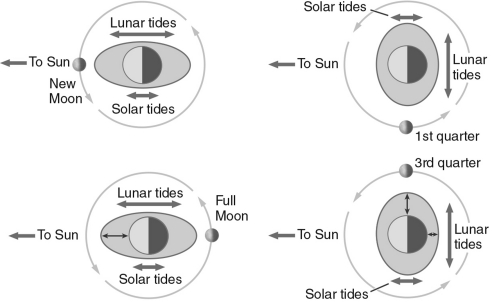
A) add; above-average
B) partially cancel out; above-average
C) add; below-average
D) partially cancel out; below-average
E) completely cancel out; no

A) add; above-average
B) partially cancel out; above-average
C) add; below-average
D) partially cancel out; below-average
E) completely cancel out; no

Unlock Deck
Unlock for access to all 100 flashcards in this deck.
Unlock Deck
k this deck
49
The Moon keeps the same hemisphere facing Earth because the ________ is equal to the ________.
A) rotational period of Earth; orbital period of the Moon around Earth
B) orbital period of Earth; orbital period of the Moon around Earth
C) orbital period of the Moon around Earth; rotational period of Earth
D) rotational period of the Moon; orbital period of the Moon around Earth
E) rotational period of Earth; orbital period of Earth
A) rotational period of Earth; orbital period of the Moon around Earth
B) orbital period of Earth; orbital period of the Moon around Earth
C) orbital period of the Moon around Earth; rotational period of Earth
D) rotational period of the Moon; orbital period of the Moon around Earth
E) rotational period of Earth; orbital period of Earth

Unlock Deck
Unlock for access to all 100 flashcards in this deck.
Unlock Deck
k this deck
50
The Moon always keeps the same face toward Earth because
A) of the Moon's own tidal forces on itself.
B) of tidal forces from the Sun.
C) of tidal forces from Earth.
D) of the combined tidal forces from Earth and the Sun.
E) all sides of the Moon face Earth at one time or another.
A) of the Moon's own tidal forces on itself.
B) of tidal forces from the Sun.
C) of tidal forces from Earth.
D) of the combined tidal forces from Earth and the Sun.
E) all sides of the Moon face Earth at one time or another.

Unlock Deck
Unlock for access to all 100 flashcards in this deck.
Unlock Deck
k this deck
51
According to the figure below, when the Moon is in between Earth and the Sun, ________ tides occur. 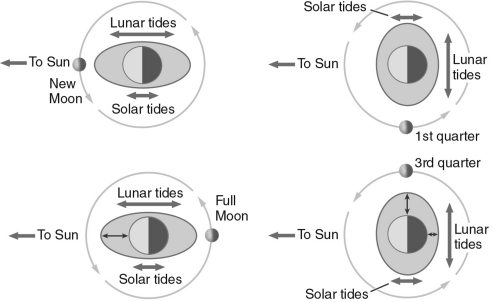
A) spring
B) no
C) neap
D) high
E) low

A) spring
B) no
C) neap
D) high
E) low

Unlock Deck
Unlock for access to all 100 flashcards in this deck.
Unlock Deck
k this deck
52
According to the figure below, neap tides occur when the lunar and solar tides ________, resulting in ________ tides. 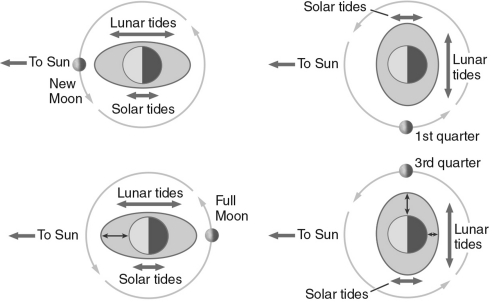
A) add; above-average
B) partially cancel out; above-average
C) add; below-average
D) partially cancel out; below-average
E) completely cancel out; no

A) add; above-average
B) partially cancel out; above-average
C) add; below-average
D) partially cancel out; below-average
E) completely cancel out; no

Unlock Deck
Unlock for access to all 100 flashcards in this deck.
Unlock Deck
k this deck
53
When one object is tidally locked to the larger object it is orbiting, it
A) will be destroyed by tidal forces.
B) will be ejected from its orbit soon after.
C) experiences 2 high tides at every location per single rotation.
D) will have increased self-gravity, making it close to a perfect sphere.
E) rotates exactly once during each orbit.
A) will be destroyed by tidal forces.
B) will be ejected from its orbit soon after.
C) experiences 2 high tides at every location per single rotation.
D) will have increased self-gravity, making it close to a perfect sphere.
E) rotates exactly once during each orbit.

Unlock Deck
Unlock for access to all 100 flashcards in this deck.
Unlock Deck
k this deck
54
Assume that a planet just like Earth orbits the bright star named Sirius.If this Earth-like planet orbits with a semimajor axis of 1 AU and an orbital period of 7 months, what is the mass of Sirius?
A) 3 MSun
B) 12 MSun
C) 8 MSun
D) 5 MSun
E) 17 MSun
A) 3 MSun
B) 12 MSun
C) 8 MSun
D) 5 MSun
E) 17 MSun

Unlock Deck
Unlock for access to all 100 flashcards in this deck.
Unlock Deck
k this deck
55
Tidal forces can affect
A) moons.
B) galaxies.
C) planets.
D) satellites.
E) all of these
A) moons.
B) galaxies.
C) planets.
D) satellites.
E) all of these

Unlock Deck
Unlock for access to all 100 flashcards in this deck.
Unlock Deck
k this deck
56
In the figure below, the person on the Moon is standing at the same location on the Moon as the Moon rotates around its own axis.Based on this, we see that the Moon's rotational period about its own axis is equal to 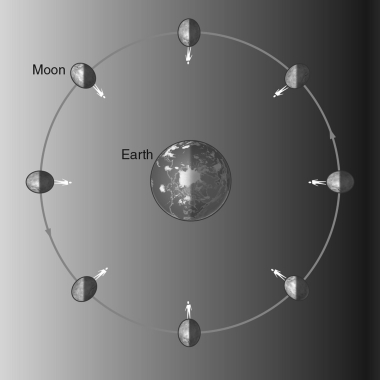
A) Earth's rotational period.
B) half Earth's rotational period.
C) the Moon's orbital period.
D) half the Moon's orbital period.
E) Earth's orbital period around the Sun.

A) Earth's rotational period.
B) half Earth's rotational period.
C) the Moon's orbital period.
D) half the Moon's orbital period.
E) Earth's orbital period around the Sun.

Unlock Deck
Unlock for access to all 100 flashcards in this deck.
Unlock Deck
k this deck
57
When the Sun and Moon are separated by 90 degrees in the sky, ________ tides occur on Earth when the strength of the tides are ________ than normal.
A) spring; lower
B) spring; higher
C) lunar; lower
D) neap; lower
E) neap; higher
A) spring; lower
B) spring; higher
C) lunar; lower
D) neap; lower
E) neap; higher

Unlock Deck
Unlock for access to all 100 flashcards in this deck.
Unlock Deck
k this deck
58
According to the figure below, neap tides occur at which phases of the Moon? 
A) new and full
B) third quarter
C) first and third quarters
D) full
E) new

A) new and full
B) third quarter
C) first and third quarters
D) full
E) new

Unlock Deck
Unlock for access to all 100 flashcards in this deck.
Unlock Deck
k this deck
59
If you doubled the distance the Moon is from Earth, by what fraction does the strength of the tidal force change?
A) 2
B) 1/2
C) 1/4
D) 1/8
E) 1/16
A) 2
B) 1/2
C) 1/4
D) 1/8
E) 1/16

Unlock Deck
Unlock for access to all 100 flashcards in this deck.
Unlock Deck
k this deck
60
According to the figure below, when Earth is in between the Moon and the Sun, ________ tides occur. 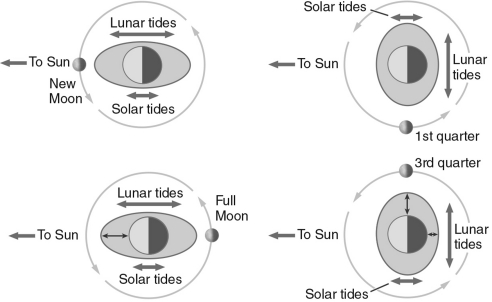
A) spring
B) no
C) neap
D) high
E) low

A) spring
B) no
C) neap
D) high
E) low

Unlock Deck
Unlock for access to all 100 flashcards in this deck.
Unlock Deck
k this deck
61
Because of the tidal force between Earth and the Moon,
A) Earth's rotation rate is decreasing.
B) the Moon's distance from Earth is increasing.
C) the Moon's orbital period is increasing.
D) the Moon's rotational period is increasing.
E) All of these are true.
A) Earth's rotation rate is decreasing.
B) the Moon's distance from Earth is increasing.
C) the Moon's orbital period is increasing.
D) the Moon's rotational period is increasing.
E) All of these are true.

Unlock Deck
Unlock for access to all 100 flashcards in this deck.
Unlock Deck
k this deck
62
How much stronger is the gravitational force of the Sun on Earth compared to the gravitational force of the Sun on Pluto? Note that Pluto's semimajor axis is 40 AU, and Pluto's mass is 0.002 times the mass of Earth.

Unlock Deck
Unlock for access to all 100 flashcards in this deck.
Unlock Deck
k this deck
63
The distance between Earth and the Moon
A) will never change.
B) is slowly decreasing.
C) is slowly increasing.
D) will increase or decrease depending on future changes in the tides on the Moon due to Earth.
E) will increase or decrease depending on future changes in the tides on Earth due to the Moon.
A) will never change.
B) is slowly decreasing.
C) is slowly increasing.
D) will increase or decrease depending on future changes in the tides on the Moon due to Earth.
E) will increase or decrease depending on future changes in the tides on Earth due to the Moon.

Unlock Deck
Unlock for access to all 100 flashcards in this deck.
Unlock Deck
k this deck
64
Explain why the gravitational force an object experiences from Earth can be considered to come from the center of Earth.

Unlock Deck
Unlock for access to all 100 flashcards in this deck.
Unlock Deck
k this deck
65
The distance between Earth and the Moon is increasing because of
A) the expansion of the universe.
B) the expansion of the Solar System.
C) tidal forces from the Moon.
D) tidal forces from the Moon and Sun.
E) dark energy.
A) the expansion of the universe.
B) the expansion of the Solar System.
C) tidal forces from the Moon.
D) tidal forces from the Moon and Sun.
E) dark energy.

Unlock Deck
Unlock for access to all 100 flashcards in this deck.
Unlock Deck
k this deck
66
Show that the gravitational pull on Earth from the Sun is about 200 times the gravitational pull on Earth from the Moon.For reference, Moon's mass is 7.3 *10 22 kg, the Sun's mass is
2 *1030 kg, the Earth-Moon distance is 3.8 * 105 km, and the Earth-Sun distance is 1.5 *108 km.
2 *1030 kg, the Earth-Moon distance is 3.8 * 105 km, and the Earth-Sun distance is 1.5 *108 km.

Unlock Deck
Unlock for access to all 100 flashcards in this deck.
Unlock Deck
k this deck
67
How does the force of gravity between the Sun and Mercury compare to the gravitational force between the Sun and Earth? Note that the semimajor axis of Mercury's orbit is 0.4 AU, and Mercury's mass is 0.06 times the mass of Earth.

Unlock Deck
Unlock for access to all 100 flashcards in this deck.
Unlock Deck
k this deck
68
________ may have been instrumental in shaping daily interactions between Earth's land and oceans, where the chemistry needed to develop life may have occurred.
A) Meteor showers
B) Collisions with comets
C) Earth's Moon
D) Tectonic activity
E) A collision with a Mars-sized object
A) Meteor showers
B) Collisions with comets
C) Earth's Moon
D) Tectonic activity
E) A collision with a Mars-sized object

Unlock Deck
Unlock for access to all 100 flashcards in this deck.
Unlock Deck
k this deck
69
Earth's rotation rate is slowing because of
A) radioactive decay in its core.
B) relativistic effects of gravity.
C) tidal forces from the Moon.
D) the gravitational force of the Sun.
E) gravitational drag from dark matter.
A) radioactive decay in its core.
B) relativistic effects of gravity.
C) tidal forces from the Moon.
D) the gravitational force of the Sun.
E) gravitational drag from dark matter.

Unlock Deck
Unlock for access to all 100 flashcards in this deck.
Unlock Deck
k this deck
70
Newton's law of gravitation says that gravity is a mutually attractive force.Explain the following observation: A small object is dropped on Earth and we see it fall toward Earth.However, we do not observe Earth moving toward the object.

Unlock Deck
Unlock for access to all 100 flashcards in this deck.
Unlock Deck
k this deck
71
Saturn has 95 times the mass of Earth, and its atmosphere extends outward 9.5 times Earth's radius.How does the acceleration due to gravity at the edge of Saturn's atmosphere compare to that on Earth?

Unlock Deck
Unlock for access to all 100 flashcards in this deck.
Unlock Deck
k this deck
72
Because of tidal forces, which type of eclipse will become impossible first?
A) partial lunar
B) total lunar
C) partial solar
D) total solar
E) annular solar
A) partial lunar
B) total lunar
C) partial solar
D) total solar
E) annular solar

Unlock Deck
Unlock for access to all 100 flashcards in this deck.
Unlock Deck
k this deck
73
How would the acceleration due to gravity on a planet that is 16 times as massive as Earth and 4 times its radius compare to the acceleration of gravity on Earth?

Unlock Deck
Unlock for access to all 100 flashcards in this deck.
Unlock Deck
k this deck
74
Because of tidal forces, for every ________ time(s) it rotates on its axis, Mercury revolves around the Sun ________ time(s).
A) 1; 1
B) 2; 3
C) 3; 2
D) 10; 1
E) 20; 1
A) 1; 1
B) 2; 3
C) 3; 2
D) 10; 1
E) 20; 1

Unlock Deck
Unlock for access to all 100 flashcards in this deck.
Unlock Deck
k this deck
75
The Roche limit
A) is the distance at which a planet's tidal forces become equal to the self-gravity of an object.
B) is the limit on the amount of mass an object can have in orbit.
C) is the smallest orbit possible around a planet.
D) only applies to the giant planets.
E) only applies to stars.
A) is the distance at which a planet's tidal forces become equal to the self-gravity of an object.
B) is the limit on the amount of mass an object can have in orbit.
C) is the smallest orbit possible around a planet.
D) only applies to the giant planets.
E) only applies to stars.

Unlock Deck
Unlock for access to all 100 flashcards in this deck.
Unlock Deck
k this deck
76
Mars has about one-tenth the mass of Earth and half Earth's radius.By what numerical factor does the acceleration of gravity on Mars compare to that on Earth?

Unlock Deck
Unlock for access to all 100 flashcards in this deck.
Unlock Deck
k this deck
77
Which of the statements below is true about the Roche limit of a giant planet?
A) It is about equal to the radius of the planet.
B) It is the closest to the planet that moons normally are found.
C) It is the closest to the planet that rings will be found.
D) It is the farthest from the planet that moons normally are found.
E) Because they have no solid surfaces, giant planets do not have a Roche limit.
A) It is about equal to the radius of the planet.
B) It is the closest to the planet that moons normally are found.
C) It is the closest to the planet that rings will be found.
D) It is the farthest from the planet that moons normally are found.
E) Because they have no solid surfaces, giant planets do not have a Roche limit.

Unlock Deck
Unlock for access to all 100 flashcards in this deck.
Unlock Deck
k this deck
78
Is there a difference in your weight when measured on top of a mountain 1,000 meters above sea level and when measured in a classroom 10 meters above sea level?

Unlock Deck
Unlock for access to all 100 flashcards in this deck.
Unlock Deck
k this deck
79
When two galaxies collide long streams of stars can be observed.These "tails" are caused by
A) pressure.
B) magnetic forces.
C) tidal forces.
D) Roche forces.
E) dark energy.
A) pressure.
B) magnetic forces.
C) tidal forces.
D) Roche forces.
E) dark energy.

Unlock Deck
Unlock for access to all 100 flashcards in this deck.
Unlock Deck
k this deck
80
Explain the difference between being weightless and being in free fall.

Unlock Deck
Unlock for access to all 100 flashcards in this deck.
Unlock Deck
k this deck



